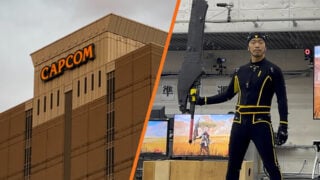PlayStation at 30: The betrayal and revenge story of the PS1
As PlayStation celebrates its 30th anniversary, we look at how it all began

Today marks the 30th anniversary of the Sony PlayStation.
On December 12, 1994, Sony entered an industry being dominated by Nintendo and Sega and threatened to become the third horse in the race.
In the three decades that have passed since then, Sony has not only remained in that race, but led it for lengthy periods, holding its own and delivering a steady stream of quality games as challengers like Sega and Microsoft dropped out and joined respectively.
To mark 30 years of the PS1, we take a look back at the story of its creation and the way Sony changed the video game landscape for good.
1991: A very public humiliation
The original PlayStation’s story is one of betrayal and revenge.
In June 1991, Ken Kutaragi – a businessman within Sony’s R&D division – arrived at the annual Consumer Electronic Show in Chicago. Kutaragi was in the USA to show off the corporation’s debut video games venture: a new kind of games console his team was planning to build in exclusive partnership with another Japanese company, Nintendo.

The concept behind the new system might have seemed simple, but it had tremendous potential. Kutaragi wanted to expand Nintendo’s popular Super Nintendo console with a CD drive add-on, boosting the system with significant processing power and speed, as well as superior sound and storage.
The terms of Sony’s deal said the SNES PlayStation would be able to play both CDs and cartridges, with Sony able to develop its own standalone system later and profit from any CD games sold.
Sony had brought prototypes of the system to CES ’91, with booth space rented specifically to show off its new joint-venture. But only one day into the event, Nintendo held a surprise press conference where its betrayal was revealed.
“Sony had Nintendo by the balls… [The Philips deal] was meant to do two things at once: give Nintendo back its stranglehold on software and gracefully f*** Sony.”
In the weeks leading to PlayStation’s unveiling, Nintendo president Hiroshi Yamauchi had secretly decided that the terms he had signed with Sony years earlier were a mistake.
With its SNES add-on, Sony would not only be able to profit from all CD games sold – which flew in the face of Nintendo’s strategy of wielding obsessive control over all Famicom software – but it had also boasted in the press of its ambitions to lean on its music and movie business to create a software line-up well beyond that of “primitive” cartridge games.
Yamauchi realised he had created not a partner, but a dangerous competitor. The sentiment was bolstered by the fact that Sony was already the sole supplier of the SNES audio chip – and it had taken advantage of this fact by forcing programmers to use an expensive Sony development tool to properly use it.
“Nintendo-Philips deal is a slap at Sony,” read the headline on the front page of the New York Times’ business section. At CES 1991 – just one day after Sony had announced its SNES partnership – Nintendo publicly revealed it had signed a deal with Sony’s rival for a similar SNES disc add-on.

“Our engineers reached the conclusion that from a technical standpoint it was better for Nintendo to work with Philips,” Nintendo of America’s Howard Lincoln told assembled press. But the real reason for the very public u-turn was far more political.
“Sony had Nintendo by the balls,” an anonymous industry consultant said in the famous industry tome Game Over by David Sheff. “It was not a tenable position as far as Hiroshi Yamauchi was concerned.” He added: “[The Philips deal] was meant to do two things at once: give Nintendo back its stranglehold on software and gracefully f*** Sony.”
Indeed it was the ultimate humiliation for the Japanese tech giant, who had found out about the deal shortly before the press conference and fought bitterly to stop the embarrassing event from going ahead. Sony’s CEO, Norio Ohga had even tried to prevent the deal by personally phoning Yamauchi and Philips boss Jan Timmer.
Despite the threat of lawsuits, Nintendo insisted the Philips deal was moving forward and that it didn’t affect Sony’s plans for the SNES PlayStation.
Outraged, Sony’s executives decided not to back out of its video game project – which the company was initially sceptical about – and push forward. At the end of a meeting to plan litigation against Nintendo, Ohga reportedly said: “We will never withdraw from this business. Keep going.”
1992 – 1994: Sweet music
Following a year of continued conflict with Nintendo, Sony finally gave up on its SNES add-on in the summer of 1992. Kutaragi, the architect of PlayStation, was frustrated by the corporation’s timid approach to ditching Nintendo and entering the games market on its own terms. This wasn’t helped by the widespread opposition within the company to what was perceived to be a toy business.
“There was a huge resistance inside the company to actually being in the videogames business at all,” explained Phil Harrison, who was headhunted by Sony in 1992 to help build its games business, during an Edge interview published years later.

“The main reason why the Sony brand wasn’t really used in the early marketing of PlayStation was not necessarily out of choice, but it was because Sony’s old guard was scared that it was going to destroy this wonderful, venerable, 50-year-old brand. They saw Nintendo and Sega as toys, so why on Earth would they join the toy business? That changed a bit after we delivered 90 per cent of the company’s profit for a few years.”
The solution was to move Ken Kutaragi and his small team to Sony Music, a separate entity within the corporation. The move was initially significant for two reasons: Sony Music knew how to attract and nurture talent, and it also controlled the disc pressing division that Kutaragi would need to launch his CD-ROM games console. Eventually, Sony Music’s involvement became key in using Nintendo’s market dominance in PlayStation’s favour.
During the days of NES (or Famicom) and SNES (Super Famicom), Nintendo enforced a strict supply and distribution model. Game developers signed contracts acknowledging that only Nintendo could manufacture and supply cartridges for their games, and even decide how many they could receive. In response, the PlayStation team leveraged Sony Music’s experience to establish a huge sales team that would help hand control of distribution back to developers.
The sales team was presented to game publishers and developers at a meeting in Tokyo in 1994 and the response was electric. Finally Japanese developers could have a say on when and how their games were sold, an area of the business that was previously controlled entirely by Nintendo. Publishers began to pledge support to PlayStation almost immediately, despite the fact it hadn’t yet announced its business model and didn’t even have a presence outside of Japan.
“That was an incredible demonstration of support and confidence, given that we hadn’t even announced the formation of the company, just Sony Computer Entertainment in November 1993,” Harrison told Edge.
Eventually, PlayStation would win over Western developers too. Publishers and game creators were attracted by Sony’s incredibly fast certification process: it would last no more than two weeks, compared to months with Sega and Nintendo. The business would also offer far more reasonable royalty rates, and Sony did not yet have its own first-party games in production, meaning less competition (that later changed with the part-acquisition of Wipeout developer Psygnosis).

One of PlayStation’s biggest pre-launch partners was Namco, which left Harrison stunned when it presented a demo of Ridge Racer to him during a 1994 studio tour. “I remember realising that was going to be pivotal piece of software for the west in particular,” he said.
Harrison added: “It was almost an afterthought. One of the men demonstrating Ridge Racer asked, since I was there, would I like them to show me another game they’re working on? ‘Yeah sure’, I said. ‘What’s it called?’ ‘It’s called Tekken’.”
December 1994: Start your engines
By the PlayStation’s December 3, 1994 Japanese release, Ridge Racer was by far the most appealing launch title of an eight-game roster, six of which never released in the West.
Regardless, Sony shipped 100,000 PlayStation consoles to retailers across Japan and immediately sold them all on their first day of availability. Cautiously, the company distributed another 200,000 units in December, all of which sold out again. Sony was clearly onto something, but its executives – still doubting the move into the video games industry – remained dubious.

Ahead of the Japanese launch Sony had sent notices to its marketing teams insisting that the console was referred to as ‘PlayStation’ and not ‘Sony PlayStation’, a clear distancing of the two brands in case the launch was to fail. The corporation knew the real test for whether PlayStation could succeed was in Europe and the US, where the console would not launch until September 1995.
Shortly after the Japanese launch, Sony began planning for the Western expansion. One of the first issues was the name, with many American executives worried how ‘PlayStation’ was faring among youth groups. Sony dismissed requests to name the console ‘PSX’, after the project’s codename, claiming that the hugely successful Walkman had also received a poor reaction from focus groups before launch.
An industry veteran by the name of Steve Race, a former Sega and Nintendo executive known for his aggressive business tactics, was hired to spearhead the American development operation. You might not have heard of Steve Race (he left Sony and the industry after just a few years), but you’re probably aware of his defining moment.
On May 11, 1995 Sega was ramping up plans for its Sega Saturn console, having become wary of Sony’s successful PlayStation launch in Japan. At that year’s E3 show the platform holder made one of the most aggressive business moves in games history, announcing that it had covertly shipped Sega Saturn to retailers across America, and that it was going to be available from that day, for $399.
It was an incredibly bold move (though eventually a disastrous one), which forced the spotlight on Sony and its plans for the US PlayStation launch. In Japan, Sony had priced the PlayStation competitively, putting the business at a loss. However, in the West consoles were traditionally more expensive and it was unclear if Sony would be able to match Sega’s price point.
At Sony’s E3 press conference the next day, the company deliberately bored its audience with a slow, jargon-filled presentation, a cruel piece of theatre that led up to Race calmly walking up to the stage podium. He approached the microphone, paused, then said the number “299” before walking off. The crowd burst into applause.
The price point was far lower than expected. Combined with a radical marketing campaign that targeted not teenagers, but twentysomethings with licensed music and sponsored nightclub events, PlayStation quickly dominated in the West.
PlayStation launched in the US on September 9, 1995 and by Christmas Sony had sold almost a million consoles – double that of Sega’s Saturn, which was left overpriced and poorly marketed thanks to the surprise launch. In Europe, PlayStation arrived in November and shipped over 600,000 units.
The console was an immediate success and its popularity continued for years.
Across its lifespan, Sony went on to sell over 100 million PlayStation One consoles, with classic titles such as Gran Turismo, Tomb Raider, Metal Gear Solid and Final Fantasy VII defining the entire generation.
With more sales than Nintendo’s Super NES and its successor combined, Sony had pushed its former betrayer into a distant second place. But more than that, it had transformed the market and fundamentally changed the game.
Further reading:














